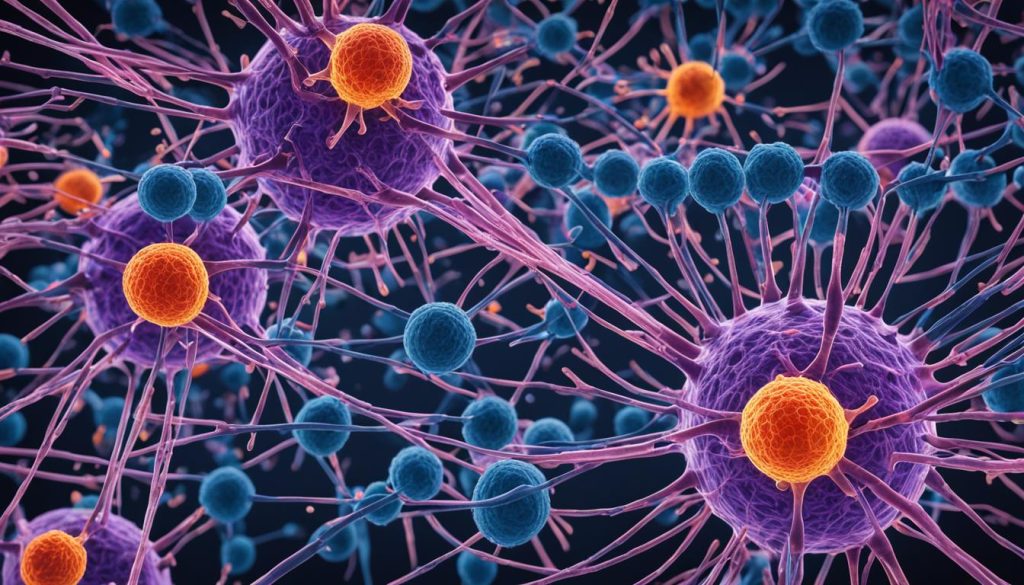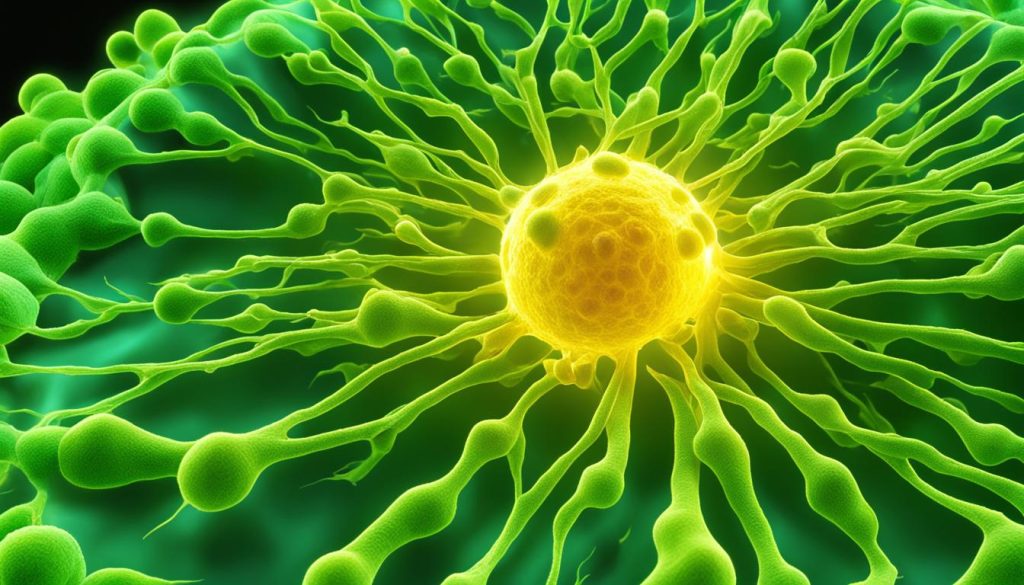In recent years, researchers have made groundbreaking discoveries that have shed light on the role of vitamin D in cancer treatment. Traditionally known as an essential nutrient for bone health, vitamin D has now emerged as a powerful agent capable of shutting down cancer cells. In this section, we will explore the latest insights into how vitamin D exerts its anticancer effects and the potential implications for cancer prevention and treatment.
Key Takeaways:
- Vitamin D possesses the ability to shut down cancer cells.
- Research has revealed new insights into the mechanisms behind vitamin D’s effect on cancer cells.
- Vitamin D plays a significant role in cancer prevention and treatment.
Understanding Vitamin D: A Hormone Essential for Health
In this section, we will explore the dual role of vitamin D, highlighting its importance as both a nutrient and a hormone essential for overall health. Vitamin D, also known as the “sunshine vitamin,” plays a crucial role in various bodily functions and is necessary for maintaining optimal health.
The Dual Role of Vitamin D: From Nutrient to Hormone
Vitamin D is unique because it can be obtained from both dietary sources and synthesized in the skin through exposure to sunlight. When we consume foods rich in vitamin D or take supplements, our bodies convert it into its active form, known as calcitriol, which then acts as a hormone in various tissues throughout the body.
Calcitriol, the active hormonal form of vitamin D, binds to receptors in cells and acts as a regulator, influencing gene expression and cellular functioning. This process is crucial for maintaining a healthy immune system, regulating calcium and phosphorus levels, promoting bone health, supporting muscle function, and even influencing mental health.
Impact of Vitamin D Deficiency on Overall Health
Vitamin D deficiency is a widespread issue, affecting people of all ages and ethnicities. Insufficient exposure to sunlight, limited dietary intake, and certain medical conditions can contribute to low levels of vitamin D in the body.
Research has shown that vitamin D deficiency is associated with an increased risk of various health problems, including:
- Reduced bone density and increased risk of osteoporosis and fractures
- Impaired immune system function, leading to increased susceptibility to infections
- Increased risk of chronic diseases, such as cardiovascular disease, diabetes, and autoimmune disorders
- Mood disorders, such as depression and seasonal affective disorder
It is crucial to maintain adequate levels of vitamin D to support overall health and prevent the onset of these diseases. Regular exposure to sunlight, consumption of vitamin D-rich foods (such as fatty fish, fortified dairy products, and egg yolks), and appropriate supplementation can help optimize vitamin D levels.
By understanding the dual role of vitamin D as both a nutrient and a hormone, and recognizing the impact of vitamin D deficiency on overall health, we can prioritize strategies to ensure adequate vitamin D intake and maximize its benefits. In the next section, we will explore the scientific mechanisms behind how vitamin D is able to shut down cancer cells.
The Science Behind How Vitamin D Shuts Down Cancer Cells
In this section, we will delve into the scientific mechanisms behind how vitamin D is able to shut down cancer cells. Vitamin D has been the subject of extensive research in recent years, with studies uncovering its potential as an effective anti-cancer agent.

Vitamin D exerts its effects on cancer cells through a complex interplay of molecular pathways. One of the key mechanisms involves the induction of cancer cell apoptosis, or programmed cell death.
“Apoptosis is a highly regulated process that plays a crucial role in maintaining cellular homeostasis and preventing the formation and progression of tumors.”
Research has shown that vitamin D triggers a series of events within cancer cells that ultimately lead to their self-destruction. This process involves the activation of specific genes involved in regulating cell growth and survival, leading to the inhibition of cancer cell proliferation.
Moreover, vitamin D has been found to modulate the expression of various proteins involved in cell cycle regulation, DNA repair, and cell differentiation, ultimately driving cancer cells towards apoptosis.
Studies have also revealed that vitamin D can inhibit the growth of blood vessels that supply nutrients to tumors, a process known as angiogenesis. By suppressing angiogenesis, vitamin D reduces the ability of cancer cells to develop and metastasize.
Overall, the scientific explanation of vitamin D’s effect on cancer is a multifaceted and intriguing area of research. Through its diverse mechanisms, vitamin D demonstrates its potential as a valuable tool in cancer prevention and treatment.
Now that we understand the science behind how vitamin D shuts down cancer cells, let’s explore the metabolic pathways of vitamin D in Section 4.
Vitamin D Metabolic Pathways: The Journey from Sunlight to Cellular Function
In our bodies, vitamin D undergoes a complex series of metabolic pathways that ultimately lead to its activation and utilization in various cellular functions. Understanding these metabolic pathways is crucial for comprehending the importance of vitamin D in maintaining overall health.
Classical and Alternative Pathways of Vitamin D Metabolism
The classical pathway of vitamin D metabolism begins when our skin is exposed to sunlight. Ultraviolet B (UVB) radiation converts 7-dehydrocholesterol, a precursor molecule found in the skin, into pre-vitamin D. Pre-vitamin D is then converted into vitamin D in a heat-dependent process. Once formed, vitamin D enters the bloodstream, where it binds to vitamin D binding protein (DBP) for transport.
“Vitamin D binding protein plays a crucial role in regulating the availability and distribution of vitamin D in our bodies.”
In the liver, vitamin D undergoes hydroxylation, which converts it into 25-hydroxyvitamin D [25(OH)D]. This form of vitamin D is considered the storage form and serves as a reliable indicator of an individual’s vitamin D status. Subsequently, 25(OH)D undergoes further hydroxylation in the kidneys, yielding the active form of vitamin D, known as calcitriol.
Alternatively, vitamin D can also follow alternative metabolic pathways in various tissues and cells throughout our bodies. These alternative pathways are thought to play a role in local vitamin D signaling and exert unique physiological effects.
The Significance of Vitamin D Binding Protein in Metabolism
Vitamin D binding protein is a multifunctional protein that plays a critical role in regulating the availability and distribution of vitamin D in our bodies. It helps transport vitamin D from the skin, where it is produced, to the liver, where it undergoes initial hydroxylation. Additionally, vitamin D binding protein helps protect vitamin D from degradation and excretion, prolonging its half-life in circulation.
Furthermore, vitamin D binding protein influences the delivery of vitamin D to target tissues, including the kidneys, where the production of calcitriol takes place. Its binding capacity allows it to bind and release vitamin D depending on the specific needs of different tissues and cells.
The image above provides a visual representation of the metabolic pathways of vitamin D, highlighting the classical and alternative routes and the role of vitamin D binding protein in vitamin D metabolism.
Exploring the Anticancer Properties of Vitamin D
In this section, we will dive deeper into the specific anticancer properties of vitamin D. One of the key players in vitamin D’s role in cancer prevention is its active form known as calcitriol. Calcitriol has been found to exert potent anticancer effects by inhibiting cancer cell growth and promoting apoptosis.

Calcitriol: The Active Form of Vitamin D in Cancer Prevention
Calcitriol is the hormonally active form of vitamin D that plays a crucial role in cancer prevention. It interacts with specific receptors in cancer cells, leading to the inhibition of cell division and the promotion of cell death.
Studies have shown that calcitriol can regulate numerous cancer-related processes, such as angiogenesis (the formation of new blood vessels that supply tumors) and metastasis (the spread of cancer cells to other parts of the body). By targeting these processes, calcitriol helps to prevent the growth and spread of cancer.
Gene Regulation: How Vitamin D Influences Cancer Cell Growth
Vitamin D also exerts its anticancer effects by influencing gene expression in cancer cells. Calcitriol acts as a transcription factor, binding to specific regions of the DNA and regulating the expression of genes involved in cell proliferation, apoptosis, and immune response.
Through this gene regulatory mechanism, vitamin D can suppress the growth of cancer cells, induce cell death, and enhance the immune system’s ability to recognize and eliminate cancer cells. By modulating gene expression, vitamin D helps maintain the balance between cell growth and cell death, which is crucial for cancer prevention.
Overall, the exploration of the anticancer properties of vitamin D, particularly through the actions of calcitriol and gene regulation, provides exciting insights into potential strategies for cancer prevention and treatment.
The Link Between Vitamin D Levels and Cancer Risk
Epidemiological Evidence of Vitamin D’s Role in Reducing Cancer Risk
There is a growing body of evidence that highlights the link between vitamin D levels and the risk of developing various types of cancer. Epidemiological studies have consistently shown that individuals with higher vitamin D levels are associated with a lower risk of cancer incidence.
Epidemiological evidence suggests that maintaining adequate levels of vitamin D may play a crucial role in preventing and reducing the risk of cancer. Studies have shown a significant association between vitamin D deficiency and an increased risk of developing several types of cancer, including breast, colorectal, prostate, and ovarian cancer.
The mechanisms behind this link are not yet fully understood, but several theories have been proposed. Vitamin D is known to regulate cell growth, differentiation, and apoptosis, all of which are crucial processes in cancer development. It is believed that vitamin D’s ability to inhibit cell proliferation and promote cell death may contribute to its protective effects against cancer.
Furthermore, vitamin D has been shown to have anti-inflammatory and immunomodulatory properties, which can help suppress tumor growth and metastasis.
Analyses of Vitamin D Supplementation and Cancer Incidence
In addition to epidemiological evidence, studies have also investigated the impact of vitamin D supplementation on cancer incidence. These studies aim to evaluate whether increasing vitamin D levels through supplementation can decrease the risk of cancer development.
A meta-analysis of randomized controlled trials found that vitamin D supplementation was associated with a significant reduction in overall cancer incidence. The analysis included various types of cancer, such as colorectal, breast, and prostate cancer.
However, it is important to note that the results from individual studies have been mixed, with some showing a significant protective effect and others showing no significant association. Further research is needed to fully understand the role of vitamin D supplementation in cancer prevention.
Despite the inconsistencies in the study findings, maintaining optimal vitamin D levels through a combination of sunlight exposure, dietary intake, and supplementation may still be beneficial for overall health and potentially reduce the risk of cancer.
Vitamin D Resistance in Cancer Cells: Understanding the Mechanism
In the previous sections, we have explored the fascinating properties of vitamin D and its potential in cancer treatment. However, it is important to acknowledge that not all cancer cells respond to vitamin D in the same way. Some cells develop resistance to the antitumorigenic effects of this essential nutrient, posing challenges for successful therapy.
Understanding the mechanisms behind vitamin D resistance in cancer cells is crucial in order to develop strategies to overcome this obstacle. While the exact reasons for resistance are still being investigated, several factors have been identified that contribute to this phenomenon.
- Alteration in vitamin D receptor (VDR) expression: One of the key mechanisms of resistance is the reduced expression or presence of VDR, the protein responsible for mediating the effects of vitamin D. When VDR is downregulated or absent, cancer cells are unable to respond to the tumor-suppressive signals triggered by vitamin D.
- Aberrant signaling pathways: Cancer cells often have dysregulated signaling pathways that alter their response to external stimuli, including vitamin D. These pathways can interfere with the normal function of VDR and disrupt the cellular processes involved in vitamin D-mediated inhibition of tumor growth.
- Enzyme dysregulation: Enzymes responsible for the metabolism and activation of vitamin D may be dysregulated in cancer cells, affecting the availability of active forms of the nutrient within the cells. This imbalance can lead to reduced responsiveness to the antitumorigenic effects of vitamin D.

Overcoming vitamin D resistance in cancer therapy requires a multifaceted approach. Researchers are exploring various strategies to address this challenge and enhance the effectiveness of vitamin D-based treatments:
- Combination therapy: Combining vitamin D with other anticancer agents, such as chemotherapy or targeted therapies, can potentially overcome resistance by targeting multiple pathways involved in tumor growth.
- VDR agonists: Developing synthetic compounds that mimic the action of vitamin D or potentiate VDR signaling may bypass the resistance mechanisms and exert antitumorigenic effects in resistant cancer cells.
- Epigenetic modulation: Targeting epigenetic modifications that influence VDR expression and function can help restore the responsiveness of cancer cells to vitamin D.
By unraveling the mechanisms of resistance and exploring innovative strategies, researchers are paving the way for improved vitamin D-based cancer therapies. Overcoming vitamin D resistance in cancer cells holds great potential for enhancing treatment outcomes and providing new hope for patients.
Advancements in Vitamin D-Based Cancer Therapy
In recent years, there have been significant advancements in the field of vitamin D-based cancer therapy. Researchers and healthcare professionals have been uncovering new insights and exploring innovative strategies to harness the potential of vitamin D in the treatment of cancer.
The Challenge of Hypercalcemia in High-Dose Vitamin D Treatments
While high-dose vitamin D treatment has shown promise in combating cancer, it does come with challenges. One of the key challenges is the risk of hypercalcemia, a condition characterized by an excess of calcium in the blood. Hypercalcemia can have serious consequences for patients undergoing high-dose vitamin D therapy, and it requires careful monitoring and management.
New Strategies to Overcome Vitamin D Resistance in Cancer Therapy
Another area of focus in vitamin D-based cancer therapy is overcoming resistance to vitamin D treatment. Some cancer cells develop resistance to the anticancer properties of vitamin D, limiting its effectiveness as a therapeutic option. However, researchers are developing new strategies and approaches to tackle this resistance. These include combination therapies, targeted delivery systems, and novel formulations that enhance the uptake and efficacy of vitamin D in cancer cells.
The advancements in vitamin D-based cancer therapy hold great promise for improving patient outcomes and expanding treatment options. As researchers continue to uncover the mechanisms behind vitamin D’s anticancer effects and develop innovative strategies, the potential for utilizing vitamin D in cancer therapy continues to grow.
Conclusion
In conclusion, the research surrounding the role of vitamin D in cancer treatment has revealed fascinating insights and potential therapeutic benefits. Throughout this article, we have explored how vitamin D is not only an essential nutrient but also a powerful hormone that can shut down cancer cells. By understanding the mechanisms behind this phenomenon, we have gained valuable knowledge about its potential implications for cancer prevention and treatment.
It is clear that maintaining adequate levels of vitamin D is crucial for overall health, as vitamin D deficiency has been linked to various diseases. However, the specific anticancer properties of vitamin D, such as the active form calcitriol’s role in cancer prevention and its influence on gene regulation in cancer cells, highlight its potential as a natural and effective therapy against cancer cells.
Further research is needed to fully understand the link between vitamin D levels and cancer risk. However, the existing evidence provided by epidemiological studies and analyses of vitamin D supplementation suggests that optimizing vitamin D levels may play a significant role in reducing the risk of developing certain types of cancer. Additionally, advancements in vitamin D-based cancer therapy, despite the challenges of high-dose treatments and vitamin D resistance in cancer cells, offer promising new strategies to overcome these obstacles.
In conclusion, the role of vitamin D in cancer treatment holds immense potential. By continuing to explore its mechanisms, optimizing its levels, and developing innovative therapeutic approaches, we can harness the power of vitamin D to combat cancer and improve patient outcomes.
FAQ
What is the role of vitamin D in shutting down cancer cells?
Vitamin D has been found to have the ability to shut down cancer cells by inducing cell death, known as apoptosis. This means that vitamin D can inhibit the growth and proliferation of cancer cells, potentially preventing the development and progression of cancer.
How does vitamin D influence cancer cell growth?
Vitamin D influences cancer cell growth by regulating gene expression in cancer cells. It has the ability to target specific genes that are involved in cell division, proliferation, and apoptosis. By modulating gene expression, vitamin D can control the growth and behavior of cancer cells.
Can vitamin D prevent cancer?
There is growing evidence to suggest that maintaining adequate levels of vitamin D can reduce the risk of certain types of cancer. Epidemiological studies have shown a link between higher vitamin D levels and a decreased risk of developing cancers such as breast, colorectal, and prostate cancer.
How can I ensure I have enough vitamin D?
The primary source of vitamin D is sunlight exposure. Spending time outdoors and allowing your skin to be exposed to sunlight can help your body produce vitamin D. Additionally, certain foods like fatty fish, fortified dairy products, and egg yolks contain vitamin D. If necessary, vitamin D supplements can also be taken to maintain adequate levels.
Can vitamin D supplements be used as a natural cancer treatment?
While vitamin D supplements may have potential benefits in cancer treatment, they should not be considered as a standalone or exclusive form of therapy. Consult with a healthcare professional to determine the best treatment approach for your specific condition. Vitamin D supplementation may be recommended as part of an overall treatment plan.
Are there any risks associated with high-dose vitamin D treatments?
High-dose vitamin D treatments can pose a risk of hypercalcemia, which is an excessively high level of calcium in the blood. This can lead to symptoms such as nausea, vomiting, confusion, and kidney problems. It is important to work with a healthcare professional to determine the appropriate dosage of vitamin D for your individual needs.
Is there a way to overcome vitamin D resistance in cancer therapy?
Overcoming vitamin D resistance in cancer therapy is an area of active research. New strategies and approaches are being developed to enhance the effectiveness of vitamin D treatment in resistant cancer cells. These may include combination therapies, targeted drug delivery systems, and novel drug formulations.

